Earlier this year, I had the opportunity to have Nicholas Hunt from Arkansas Life Magazine ride along on a storm chase through Oklahoma and Arkansas. Nick was doing a story on storm chasing and wanted to get a feel for the real thing. Although the spring was quiet, Erich Hopkins and I decided to venture out to Oklahoma one spring day in April. We knew there would be severe weather in Arkansas the next day, but wanted to make a run out to south-central Oklahoma in hopes of capturing some lightning from supercells that were expected to develop. On our way back, we encountered severe weather in Arkansas and were on three tornado warned storms. It was a pleasure to have Nick along with us, and I have to say, he’s quite the up and coming journalist. This was his first storm chase and I’m pretty sure it won’t be his last. I want to thank him for writing the article and thanks to Sara Blancett and Nick for the awesome pictures they took.
Here is the article that was in the August issue of Arkansas Life Magazine. If you’ve never seen this magazine, you should check it out. After reading just a few copies, I knew this was a magazine I wanted to subscribe to. Here is the link so you can explore what Arkansas Life Magazine has to offer: www.arkansaslife.com
The Long Chase Home
On April 27, three Arkansas storm chasers were excited for the first big chase of the year. They had no idea what was coming.
BY NICHOLAS HUNT | PHOTOGRAPHY BY SARA BLANCETT AND NICHOLAS HUNT
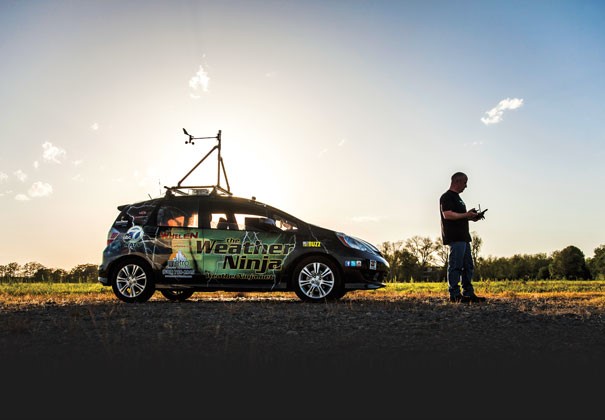
Racing east on Interstate 40 as fast as the law and the weather will allow, Eric Hopkins calls his wife a second time. His end of the conversation goes something like this: Honey, you and Brittany need to take cover right now. There is a debris ball on the radar. It’s a tornado. He doesn’t have to tell her we’re heading right for it. She already knows.
From the passenger seat, Michael Hook, aka the Weather Ninja, a veteran storm chaser and leader of this two-man storm-chasing team, tweets again to his 9,000-plus followers that anyone in Maumelle, North Little Rock and Mayflower needs to take cover immediately. Then he, too, pulls out his cell and starts calling loved ones near the tornado’s path to give them the same warning.
After just over 1,000 fruitless miles and 40 hours of chasing storms out and back across the Oklahoma plains, we’ve finally come home to Arkansas, but for all the wrong reasons. A precious handful of minutes earlier, right around 7:06 p.m. on April 27, a tornado touched down 5.4 miles west of Ferndale in western Pulaski County. Just shy of an hour from now, that funnel cloud will dissipate into the gray evening sky. But between now and then, 15 people will lose their lives.
One day and 950 miles earlier, Hook, Hopkins and I are slowly being baked by the western sun in a blistering Walmart parking lot in Lawton, Oklahoma. There is a haze to the sky indicating moisture—one of the four elements needed for a tornado—but it’s all too high in the atmosphere. There is not much of a chance for a storm, much less a full-fledged tornado, but that doesn’t mean Hook and Hopkins have given up hope. And plus, if you’re a storm chaser, this potential system is the only game in town.
“You just never know what is going to happen,” Hook is telling Greg Ford, a chaser from Georgia who has pulled up to talk shop after spotting Hook’s vehicle. Storm chasers have a knack for spotting others of their kind. “How many times have you gone out on a severe-risk day and seen nothing, and how many times have you gone out on a low-risk day and gotten on a storm?”
“Tenacity is everything, no doubt,” says Ford, a pastor in his non-chase life.
They sound like they are trying to convince themselves that driving all this way was really worth it. The storm-chasing season, roughly March through June, is nearly halfway over, and nothing much has happened. This weekend was posed to be the country’s first significant chance for severe weather, but so far it’s looking like, as storm chasers say, a monumental bust. It’s no wonder, then, that despite their insistence that they would rather be here than anywhere else, my companions can’t hide their disappointment when they look west into the powder-blue sky.
Ford’s chase vehicle is a beast of a truck, complete with a custom-built “hail grate”—a metal frame covered in thick wire mesh and mounted to the roof to protect the cab from falling debris while still allowing high winds to slip through. On the truck’s tailgate, he’s slapped a magnetic sign that reads “Weather Research Vehicle.” (“Yeah, we do research,” he says and then laughs. “But it’s personal research.”)
But despite the sign, one look at the vehicle and you can tell Ford and his partner are amateurs. Hook’s vehicle, on the other hand, is impressive. It’s a small, four-door Honda with NASCAR-style sponsor logos, a police-style emergency lightbar, and a homemade wind-speed-measuring device called an anemometer mounted to the roof. Hook may look the part, but he is the first to admit that he is no professional.
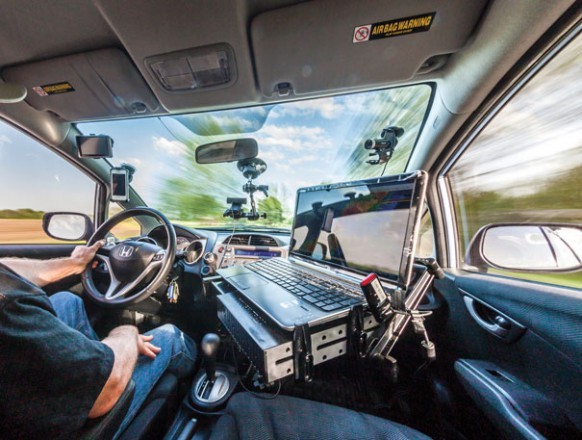
“You will hear this a lot from storm chasers. They will say, ‘I’m out there to serve the public. I am out there to save lives.’ I do contact the National Weather Service and stream for the local media, but that is not why I am out there,” Hook says. “I am not going to lie about it. I am out there because this is a hobby. I am not a research scientist. It is just something I love to do. It is a passion.”
Storm chasing entered the popular consciousness in 1996 with the movie Twister, although the hobby remained mostly inaccessible for all but the most dedicated chasers until the mid-2000s, when two factors led to an explosion in the number of chasers: the widespread adoption of smartphones and other mobile technologies, and the premiere of the Discovery Channel documentary series Storm Chasers.
“In the last six to eight years, it has really exploded,” says Hook, one of Arkansas’ best-known chasers, thanks to his massive Twitter following and work streaming severe-weather video for KATV, one of his many sponsors. “You really need to know what you are doing to get close to a tornado, and that is where the danger is. There are a lot of people who have their cameras and their phones and are hanging out their windows, and they are really putting themselves in some dangerous situations.”
While Hook warns against this type of chasing and the harm it is doing to the community’s reputation, he also understands it. Their passion is also his, and he can hardly fault them for that.
At 55, Hook is one of the older chasers out there. Growing up in the San Francisco Bay Area, he wasn’t accustomed to thunderstorms and tornadoes the way many Arkansans are. It was the 1974 super outbreak—a storm system stretching from Alabama to Michigan infamous for spawning the second-largest number of tornadoes ever recorded in a 24-hour period—that first spiked his interest in severe weather. In 1975, his family moved to Arkansas, and he has been chasing on and off ever since. Five years ago, he began what he calls “high-tech chasing.”
“In the early days, if you wanted to have radar in your car, you would have to have a little portable TV and pull in the local stations,” he says. “Now I have got multiple radar connections in my vehicle, and then there is everything you can get on your cell.”
I look around the parking lot again and spot several other chase groups a few rows over. They all look the same. They all look like amateurs, albeit very serious amateurs, doubtlessly having the same conversation we are. Swapping fish stories has got nothing on swapping storm stories, and those stories always begin the same way.
Were you in Shawnee, Moore, Joplin, El Reno?
El Reno.
Hang around any storm chaser long enough, and you will hear those words spoken with an aura of reverence. On May 31, 2013, an EF3 tornado touched down about 8.3 miles west of El Reno, Oklahoma. At its peak, the tornado stretched more than 2 1/2 miles in diameter, making it the widest ever recorded, but that’s not the reason it’s famous. Eight people, including three professional chasers, died when they were caught in the massive funnel’s path. It is the only known instance of any chasers, whether hobbyist or professional, being killed by a storm while chasing.
Tim Samaras, a tornado researcher and one of the chasers featured on Storm Chasers; his son, videographer Paul Samaras; and longtime chase partner meteorologist Carl Young were all killed when the storm unexpectedly changed direction and quickly increased in size and speed. Many other chasers were injured or had their vehicles severely damaged. After the storm, YouTube was awash with dash-cam videos of chasers desperately attempting to flee the funnel. Weather Channel meteorologist Mike Bettes miraculously survived after his car was tossed 200 yards. Even Reed Timmer’s famous armored chase vehicle, The Dominator 2, had its hood ripped off.
Their mistake, Hook tells me, was being stuck north of the storm. And then there was what’s called “chaser convergence.” Because of major leaps forward in the accuracy of weather forecasts and the wealth of real-time information available to anyone with a cellphone or 4G-connected computer, chasers know exactly where they need to be and often cause small traffic jams trying to get there.
“On moderate- to high-risk days, a lot of times there will be so many chasers out there—and you think about Kansas being flat, western Oklahoma being flat—well, you can get in these traffic jams where it is just bumper to bumper, all chasers,” Hook says.
El Reno was certainly a convergence, and while it may not have contributed to the chasers’ deaths, it certainly didn’t help their attempted escape.
Four days after their deaths, Jim Francis, vice president for research, conservation and exploration at the National Geographic Society and the man who gave Samaras 18 research grants over the years, spoke with the Richmond Times-Dispatch about the incident.
“It reminds me a little bit of Everest,” he said. “When you have a few people climbing, it’s fine. If you have a bunch of people stacked up and a bad situation occurs, it can be devastating. … What is an important science practice and one that is informative for the public can suddenly become an opportunity for disaster.”
The storm has become a touchstone for anyone involved in the chasing community. Almost immediately after it was discovered chasers were among the dead, debate sprang up about just what good chasers are truly doing. Meteorologists from across the country chimed in to support both sides of the argument, and Kansas toyed with the idea of banning storm chasing (“I would fight that tooth and nail,” Hook says. “It is a free country.”), or at least regulating it. But it didn’t lead to anything, mostly because a ban would be impossible to enforce.
But we see none of that controversy on the ground in Oklahoma. I lose count of how many people, even police officers, pull up to our small gathering to talk shop. Some worriedly ask if storms are coming, and others roll down their car windows to crack jokes, but everyone seems glad to see us. Everyone is interested to hear what information these chasers have to offer, especially when they say it looks like nothing is going to happen today.
We leave Ford and his chase partner behind and head off in search of the Hollingers, another Arkansas chase crew Hook knows through Twitter, and a few hours later, we end up in a wildlife refuge in the Wichita Mountains passing the time looking at buffalo and prairie dogs. But then things start to happen. The Hollingers, a father-and-son chase team, shout at us from their massive four-door pickup that some storms may be forming to the southwest. We barely have time to respond before they’re tearing off down the road. We follow after them, racing the light toward Vernon, a small Texas town right across the border from Oklahoma.
The Hollingers are quickly out of sight, and we are on our own again. Except not quite. From the backseat, I can clearly see dozens of green dots, each representing a chase team or stationary storm spotter, overlaying a weather map on Hook’s 4G-connected laptop. As the sun sets, the glow of the car’s many digital screens illuminates Hook and Hopkins’ faces in pale blue light.
Most chasers share their location on spotternetwork.com, and many stream live video feeds on websites dedicated to severe weather like Reed Timmer’s tornadovideos.net, where the Hollinger’s broadcast, or chasertv, the site Hook uses. If Hook wanted to, he could easily see exactly what the Hollinger’s were witnessing at any moment simply by clicking on their dot, and vice versa. Either way, the more viewers a stream gets, the more money it makes from the website and its advertisers. Though streaming provides a small source of revenue, only a select few make a living off chasing, and those who do are usually researchers or television meteorologists. Hook makes enough from streaming and his sponsors to cover gas, food and hotels, but doesn’t turn a profit. Most don’t even come close to that.
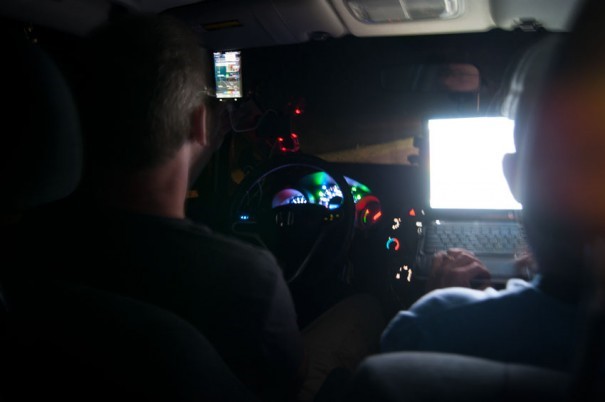
Several small storm cells pop into existence over north Texas, and we bounce back and forth, east and west, trying to catch them as they head north. It is harder than I thought, but finally it looks like we are going to make an intercept. Lightning slashes the night sky, revealing billowing clouds to the south. We are going to catch it.
The only question now is where to park. We find a small paved service road that runs parallel to the highway, and Hopkins pulls off and parks us in the middle of it, facing south. The car’s headlights illuminate the first few rows of wheat before the darkness swallows them. Then the storm comes. It’s not much—just some wind, lightning and hail—but my companions are right. It is something. Like some sort of modern-day shamen, we found rain, and there is something to be said for that.
We could continue the chase and try for a second intercept, but it’s been a long day, and we still have 170 miles to go before we can rest our heads in Shawnee. For a second, I feel bad that Hopkins and Hook have to drive all that way in the dark, but then sleep takes me.
“I’ve got this co-worker who is always messing with us. I’m pretty sure he thinks we are crazy,” Hopkins tells me the next morning as we head to Fort Smith, where we plan to watch how things develop during the late morning.
It takes me a few seconds to reply. After getting to the hotel in Shawnee around 1:30 in the morning and being on the road for nearly 24 hours the day before, it’s gotten to a point where I’m really starting to wonder why I’ve never taken up coffee.
Well, if you think about it, he does have a point, I finally say.
“Yeah, I guess he does,” Hopkins says, “but here is the way I look at it. It’s like the proverbial snake. I’d rather know where the snake is and be looking at it than to have it sneak up on me. In a way, I think doing this is almost safer.”
I hope he’s right, because the day is shaping up to be big. Arkansas is saturated with little green chaser dots. They’ve come from all corners of the nation. Somewhere out there is the small sedan stuffed with the five undergrads from North Dakota State we met late last night while topping off the tank on our way to Shawnee. The student photographer and his girlfriend from North Carolina we met while looking at buffalo in the Wichita Mountains said they were headed this way as well. Sean Casey, another famous extreme chaser, IMAX filmmaker and inventor of the Tornado Intercept Vehicle, the original armored chase vehicle, is tweeting from a little ways south of Little Rock where the Weather Channel has set up camp. Ford and his chase partner are somewhere farther south, hoping to get the storms as they spawn.
Though not atypical for big storm days out west, this is an unprecedented gathering for Arkansas. Most chasers, especially those who have been to the state before, tend to avoid it completely during the season. Even Hook and Hopkins and the state’s other crews prefer to chase in the Plains states, not just because they consistently have the highest rates of severe weather, but because the terrain is perfect for chasing. In Oklahoma the day before, the horizons stretched for miles around us, and the tight grid of roads meant we could take off in a new cardinal direction almost instantly and know exactly where the road would take us. Compared to that, the mountains, trees and winding roads of west Arkansas feel claustrophobic.
Most maps don’t include Arkansas as a traditional Tornado Alley state, and if you simply compare Arkansas’ annual average of 39 tornadoes to, say, Texas’ 122 or Kansas’ 92, it’s easy to see why. But the story is more complicated than that. Arkansas is home to four of the country’s top six counties for total number of tornado disasters, and since 1980, the state has had 34 storms that each caused over a billion dollars in damage. If you were to plot tornado deaths on a national map, the centerline would run through the state from northeast Arkansas roughly on to Alabama.
It’s one of the reasons I’m glad to be riding with experienced locals as we move east from Fort Smith, where we met up with Jesse Hays, a fellow chaser and friend of Hook’s.
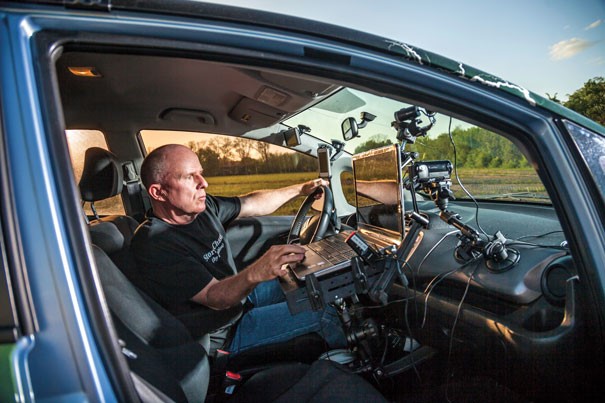
But the day has been slow so far. We’ve pulled off the interstate just outside Russellville to wait and see what the weather will do, and Hopkins, Hays and I pass the time telling jokes and skipping rocks on Lake Dardanelle. Hays is the newest chaser in the group. A skilled amateur photographer, all Hays wants is that one perfect shot, and the next one after that.
Hook yells at us from the parking lot.
“It’s time to roll!”
We scramble up the gravel bank and hop into our vehicles. A storm system we’d waited out this morning inside a do-it-yourself car wash stole some of the atmospheric energy, but now things are moving quickly, and you can feel it in the air. The National Weather Service has issued a high tornado risk for nearly the entire southern half of the state. Most chasers appear to be strung out along Interstate 530, but we’re back on I-40 now, right on the northern edge of the warning area, where we can easily scoot east or west so the storms won’t take us from the southwest like El Reno.
“Your first chase, and you get a high risk,” Hook says as we drive east hoping the open fields around Morrilton will give us a good view. “I mean, I don’t think today is going to be a bust or anything, but I am just scared that someone is going to get hit.”
It’s the classic storm chaser’s guilt, but it’s heightened this time because it’s home. Both Hook and Hopkins have seen storm destruction up close in Arkansas. As a firefighter with the Liberty Volunteer Fire Department between Conway and Vilonia, Hopkins helped clear debris at Black Oak Ranch when that small community was destroyed by a tornado in 2011.
“It’s humbling,” Hopkins says. “I’m not there for the science of it. I’m just there to experience the awesome power of nature, but at the same time, I know it affects people’s lives and will affect them forever.”
Hook’s experience is even more personal. His home was partially destroyed by a twister while he was on a business trip to North Carolina for his day job with Kimberly Clark. He saw the storm coming and called home to warn his wife. She answered, but the phone went dead when the storm hit. For 20 minutes, he did not know whether she survived. Of course, once he’d reached her and confirmed that she was safe, he had to wonder, did anyone get any video? No one did.
His wife has been frightened of storms ever since, but she still supports her husband’s obsession. She trusts him to be safe.
As we reach Dardanelle we are presented with a choice—go left or go right. The National Weather Service has issued a tornado warning for the storm to our right, meaning radar shows rotation that could indicate a tornado, but we may have already missed our chance to catch it. Left would be an easy intercept, but the storm hasn’t shown any rotation. The longer we wait, the more the decision is made for us. We decide to chase right and begin to pull away.
“Left, left. Go left,” Hook shouts. “The second storm has been tornado-warned.”
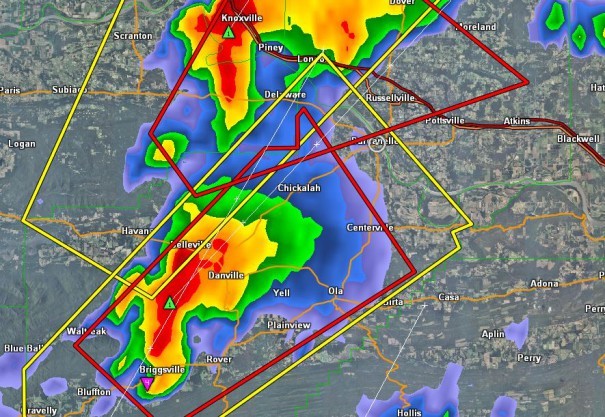
The sky is tinted green. The eerie tone of tornado sirens drift through Dardanelle, and families stand outside their homes staring skyward. I stare with them, too, until my phone buzzes. It’s an automated message warning me to take cover, as I am in the path of a possible tornado. I take it as a sign we are on the right course.
The destruction a tornado would cause the families we pass does not cross my mind.
It takes awhile for us to find a spot with a good line of sight. We finally join an ambulance in a parking lot across from an open field outside of town. The low clouds swirl broadly as if to indicate some evil sorcery just out of sight. But no tornado forms. Not even close. Another police officer pulls up and calmly asks if anything is headed our way. No, we tell him, not quite yet, but be vigilant.
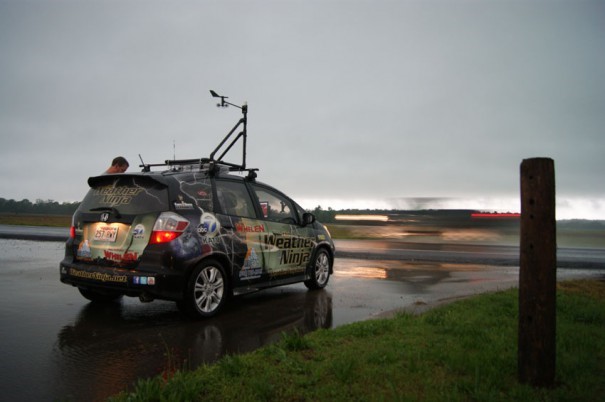
We’ve lost Hays somewhere along the way. He was impatient and headed back west without us, and when Hook calls him to meet up again, Hays answers with bad news. There was a car wreck right in front of him, and he’s waiting until an ambulance comes. It won’t be his only selfless act this day.
Though it’s raining hard when we finally catch up with him south of Russellville, there’s nothing worth chasing. We stop for gas and eat another batch of junk food and give some advice to a traveler heading west. He’s looking to avoid the worst of the storms, and Hays tells him now may be the best time to head out. The round of storms overhead is about to move on, and if he leaves immediately, he’ll be out of the area before the next one rolls through.
We take our time getting ready again. It’s been a long day, and no one seems eager to chase the next storm, even though it looks like it may be the day’s last. What we don’t realize is that this storm spawned right on the warm-front boundary, so it has plenty of energy, and because it’s late to the game, there are no other storms in the area for it to compete with. It is going to produce. On radar, however, it doesn’t look like much as we head east to meet it.
Then, all of a sudden, it starts to look dangerous.
Hook tweets immediately with an attached screen capture of the updated radar scan.
Mayflower, Maumelle keep an eye on this storm to your SW. #arwx
Winds at different altitudes in the storm cell have begun moving at different speeds and directions, causing part of the storm to roll horizontally like a corkscrew. At the same time, a strong rotating updraft of warm air pulls the corkscrew vertically. The funnel begins to tighten, and rain and hail push it downward until it finally contacts the ground. The destruction is immediate. Within a minute of touchdown, the tornado has already destroyed two homes and claimed its first lives. Later, surveys of this damage conducted by the National Weather Service will indicate wind speeds ranging from 136 to 165 mph.
On Hook’s radar, rubble sucked up by the raging winds shows up as a small area of distinct purple—a tornadic debris signature, also known as a debris ball. Hook and Hopkins immediately know what it means. Hook tweets again.
Debris ball signature on this storm. TAKE COVER IF IN THE PATH MAUMELLE, NLR, MAYFLOWER.
The mood is tense as Hook and Hopkins try to reach their loved ones. To the south, the sky grows dark in anticipation. Once the phone calls have been made, all focus turns toward a middle-school math problem: If we are traveling east at X mph and the tornado is traveling northeast at Y mph, can we safely make it to the other side in time? If we stay to the northwest of the funnel, we’ll be in the meat of the storm with no visibility. To the east is clear sky. We know our speed, but it’s difficult to judge the storm’s. All we can do is keep going.
The rain hits us hard in Conway. Visibility drops to yards, and our speed drops by half. I turn on the orange emergency lightbar on the roof—the one responsibility I’ve been given. I can barely make out the flashing hazard lights on Hays’ truck ahead of us through the downpour. Hopkins wants to get off the interstate and head east on U.S. Highway 64 to Vilonia, but Hook doesn’t think we have time. Instead, we stay on I-40 as it makes its sweeping turn outside Conway, and we head due south.
I fix my gaze southwest. The funnel is out there somewhere, but we can’t see it. In fact, the radar takes several minutes to complete a new scan and update the results, so we don’t even know where the tornado is. We only know where it was. But if it keeps its last known track, we should be safe. I am all for pressing on. The idea of missing it because we didn’t go far enough seems worse than what could happen by going too far. Hopkins feels it, too. He says he wants to keep pushing through, but Hook knows better. Hook remembers El Reno. He’s seen how badly coming at a storm from the wrong angle can end. And the radar still hasn’t updated.
“We need to pull over right now!” Hook yells.
So we do. It breaks the spell. I am suddenly relieved. I had not realized I was afraid until that moment, and I am glad we stopped. Hook and Hopkins consult their maps one last time and decide we can go just a bit farther to get around a stand of trees obstructing our view. A few hundred yards more and we pull over again, this time with a clear southerly view, though trees still block what lies to the southwest. Hays and a bunch of other drivers who understand who we are and what our maneuver must mean pull over behind us. We hop out. Traffic flies past us, kicking up rooster tails of water, but there is no way to warn the drivers what they are headed into. There is no way to tell them they are driving toward a monster. Many of the semitrailers and cars passing us now, including one group of chasers still held by the storm’s siren call, will be caught by the storm.
The meat of the storm curves around us here, and the rain has all but stopped. But looking south, the interstate disappears into a wall of gray. I start taking photos, but it is dark and my hands are shaking. Few of the photos will turn out usable. The air is strange. I kneel in the wet grass to get a wide shot of the crew when I hear Hook speak.
“There it is.”
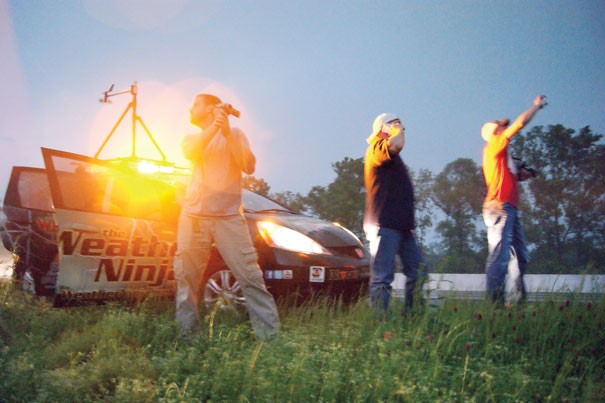
I follow his gaze, but at first I don’t see it. All I can make out is a mass of darker gray moving right to left across the roadway. Then I realize that’s it, and it’s massive. Though the heavy rain to the south obscures our view, it’s immediately obvious we are close—perhaps only a mile from the wedge-shaped funnel’s northern edge. If the tornado had turned slightly north instead of slightly east, we would have been in serious danger. If we had continued south for one or two more minutes, we very well could have died.
The tornado’s winds rage at speeds of 166 to 200 mph, ranking it a 4 out of 5 on the Enhanced Fujita scale, and the funnel has already torn Mayflower apart.
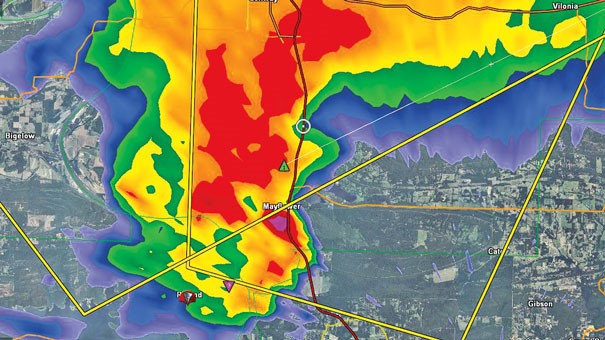
Trucks lie on their sides like lamed livestock. Power lines and downed trees stretch across the road. These are the first things Hays remembers seeing after the tornado lumbers out of view. It is a short trip to Mayflower, perhaps no longer than a 10-minute drive, but it is like a switch has been thrown.
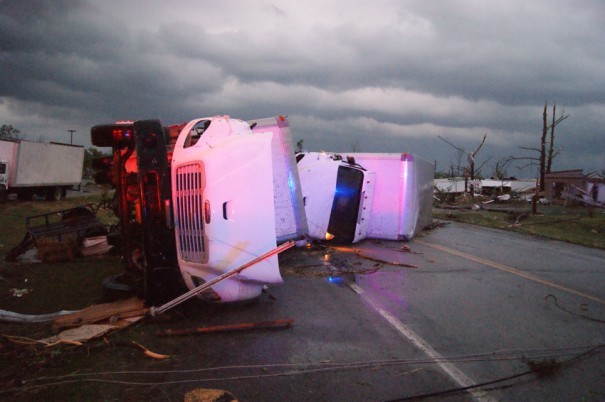
Many critics of the chaser community claim it is made up of individuals who gain pleasure from the pain and loss of others. Looking over the desolation around me, at the families who have lost everything and more, I understand that accusation. But I also see that in this case, that’s just not true. Some chasers may drive recklessly in pursuit of a storm, and some may be dangerously inexperienced, but there is no pleasure to be had here.
Here, the chase is forgotten. The tornado is forgotten. It doesn’t cross anyone’s mind that the storm is still out there and headed straight toward Vilonia. All that matters now is finding some way to help.
Both Hook and Hopkins have seen this type of destruction before. Instead of shock, the devastation fills them with urgency. For Hays, this is something entirely new, and for him, it’s more frantic.
Hays, Hopkins and I leave Hook behind to direct the stream of traffic trickling in to search for other ways to help. As a volunteer firefighter, Hopkins will spend the next week cleaning up Black Oak Farms, the same small community he helped clear three years ago, but right now the destruction he sees is humbling. He knows towns like this suffer all too often. Looking around, he knows these people will be affected by this forever.
The traffic trying to get into town grows steadily, and it surprises Hook how many of the people now trying to drive through Mayflower are unaware that a tornado has just struck. They just think they’re avoiding a traffic jam caused by a wreck on I-40. Though the damage on the interstate is immense, miraculously, no one there has died.
Later, when Hook learns that the massive funnel caught the chasers who had passed us only minutes before and destroyed their truck, he will think of El Reno and how no one seems to have learned anything at all.
As he stands there turning away everyone but those who truly need to be here—family members looking for their loved ones, first responders taking up the call—he dials the National Weather Service’s Little Rock office to report the damage. He is the only chaser who does.
For Hays, everything is a blur, but there are moments of stark comprehension. At one point he finds himself searching overturned RVs for survivors, not realizing it is a dealership and they’re all empty. There is the man he meets briefly, a young Mayflower city council member who’s just arrived to survey the damage of his town and is even more desperate to help than Hays. Then there is an old women standing amid a tangle of downed trees and power lines in her front lawn, holding up her hand. From a distance it looks like she is bleeding profusely, but it’s just a red dog leash for a small Lab with a broken hind leg. Together with some others, Hays helps carry the dog to safety and stops the woman as she reaches out to steady herself on one of the downed lines. After surviving what she just went through, he thinks, she doesn’t need to press her luck any further.
He’ll later learn that at some point, he was within 15 to 20 yards of a couple calling for help from inside their ruined home, and he never heard them. But out of all these snapshots, there is one constant—the smell of gas. It is something Hays has experienced a thousand times before, but never like this. Months after the storm, its stench will fill his nose every time he thinks of this night.
In the weeks and months that follow, Hays finds himself a changed man. Like Hook and Hopkins, he still plans to keep chasing, but it is no longer about getting that perfect photo. His primary focus now, he says, will be to act as a mobile spotter, to call in reports and help get the word out.
The storm’s aftermath changes him on a more personal level, too. Mayflower, so very much like his hometown of Atkins, becomes a second home, and he commits himself to its recovery. He watches as the number of volunteers swell those first few weekends, then dwindle away. But it doesn’t upset him. He understands that’s just human nature.
One day, not long after the storm, while unloading a truckload of donations, Hays looks over at the man next to him and finds he recognizes his face. It takes a moment before he realizes it is the city council member he met the night of the storm. For Hays, it’s like they share a bond forged in battle. It is an instant friendship he expects will last for the rest of his life.
“You want to surround yourself with people who would run toward that scene to help,” he says. “We all had an option, but we all ran towards it.”

Leave a Reply